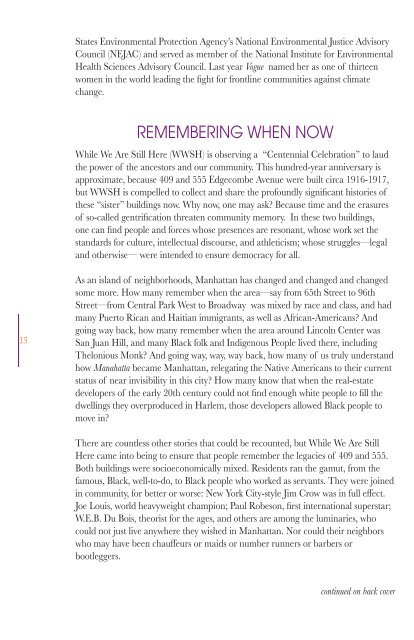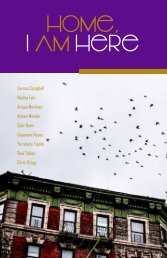2016 When Sugar Hill Was Sweet Program Booklet
This booklet is an archived copy of the booklet WWSH published for its first year of programming.
This booklet is an archived copy of the booklet WWSH published for its first year of programming.
Create successful ePaper yourself
Turn your PDF publications into a flip-book with our unique Google optimized e-Paper software.
States Environmental Protection Agency’s National Environmental Justice Advisory<br />
Council (NEJAC) and served as member of the National Institute for Environmental<br />
Health Sciences Advisory Council. Last year Vogue named her as one of thirteen<br />
women in the world leading the fight for frontline communities against climate<br />
change.<br />
remembering when now<br />
While We Are Still Here (WWSH) is observing a “Centennial Celebration” to laud<br />
the power of the ancestors and our community. This hundred-year anniversary is<br />
approximate, because 409 and 555 Edgecombe Avenue were built circa 1916-1917,<br />
but WWSH is compelled to collect and share the profoundly significant histories of<br />
these “sister” buildings now. Why now, one may ask? Because time and the erasures<br />
of so-called gentrification threaten community memory. In these two buildings,<br />
one can find people and forces whose presences are resonant, whose work set the<br />
standards for culture, intellectual discourse, and athleticism; whose struggles—legal<br />
and otherwise— were intended to ensure democracy for all.<br />
15<br />
As an island of neighborhoods, Manhattan has changed and changed and changed<br />
some more. How many remember when the area—say from 65th Street to 96th<br />
Street—from Central Park West to Broadway was mixed by race and class, and had<br />
many Puerto Rican and Haitian immigrants, as well as African-Americans? And<br />
going way back, how many remember when the area around Lincoln Center was<br />
San Juan <strong>Hill</strong>, and many Black folk and Indigenous People lived there, including<br />
Thelonious Monk? And going way, way, way back, how many of us truly understand<br />
how Manahatta became Manhattan, relegating the Native Americans to their current<br />
status of near invisibility in this city? How many know that when the real-estate<br />
developers of the early 20th century could not find enough white people to fill the<br />
dwellings they overproduced in Harlem, those developers allowed Black people to<br />
move in?<br />
There are countless other stories that could be recounted, but While We Are Still<br />
Here came into being to ensure that people remember the legacies of 409 and 555.<br />
Both buildings were socioeconomically mixed. Residents ran the gamut, from the<br />
famous, Black, well-to-do, to Black people who worked as servants. They were joined<br />
in community, for better or worse: New York City-style Jim Crow was in full effect.<br />
Joe Louis, world heavyweight champion; Paul Robeson, first international superstar;<br />
W.E.B. Du Bois, theorist for the ages, and others are among the luminaries, who<br />
could not just live anywhere they wished in Manhattan. Nor could their neighbors<br />
who may have been chauffeurs or maids or number runners or barbers or<br />
bootleggers.<br />
continued on back cover





